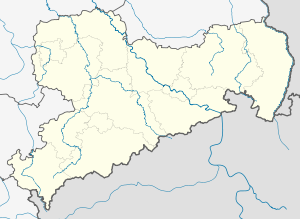Budapester Strasse bridge
Coordinates: 51 ° 2 ′ 38 " N , 13 ° 43 ′ 31" E
| Budapester Strasse bridge | ||
|---|---|---|
| Bridge Budapester Straße, view from the south with the staircase on the southeast side | ||
| use |
|
|
| Convicted | * Track field of the main train station | |
| place | Dresden | |
| overall length | 850 m | |
| opening | December 28, 1967 | |
| planner | Eckhardt Thürmer | |
| location | ||
|
|
||
The Budapester Strasse bridge is a road bridge in Dresden that is named after the Budapester Strasse that runs over it . The bridge is 850 meters long and spans the western track field of Dresden Central Station , a double-track line of the Dresden tram and Ammonstraße ( 26er Ring ).
location
The Budapester Strasse bridge is located in the southwest of Dresden city center. It forms the border between the Wilsdruffer and the Seervorstadt . The Wilsdruffer Vorstadt and the western part of the Seevorstadt are largely combined to form the Wilsdruffer Vorstadt / Seevorstadt-West district. The boundaries of the district and the Old Town I district run directly south of the bridge.
The building begins shortly after the confluence of Wielandstrasse and Budapester Strasse. It consists of two directional lanes , which on two "single bridges" pass first the railway line and then the depot of the regional traffic Saxon Switzerland-Eastern Ore Mountains. Then branch roads branch off from both parts, which connect the bridge to Ammonstraße in a manner similar to interchanges on motorways . Another ramp branches off shortly after the end of the bridge in the direction of Dippoldiswalder Platz and leads to the other lane on Ammonstraße. In the opposite direction of travel there is no such ramp due to lack of space.
If the bridge is crossed completely, Budapester Strasse, after it crosses Josephinenstrasse, continues to Dippoldiswalder Platz, where it splits into Waisenhausstrasse and Dr.-Külz-Ring .
history
Previous buildings
Before the Second World War , the street layout in the western inner city of Dresden was fundamentally different. Up until the 1960s, there were three bridges near the current Budapester Straße bridge. The Falkenbrücke was the most important and spanned the railway line a little further west than the current one. The street continued after the end of the bridge over Sternplatz, Annenkirche and Annenstraße to Postplatz . The Hohe Brücke was located closer to the main station and led from Bismarckstrasse (today Bayrische Strasse) near the confluence of Hohen Strasse over the railway facilities to Plauenschen Platz , from the connection to Ammonstrasse and over Grosse Plauensche Strasse to Dippoldiswalder Platz duration. The former Chemnitz bridge comes closest to the current course of the bridge. It began shortly after the intersection of what was then Chemnitzer Strasse and Wielandstrasse and also ended at Plauenschen Platz. The connecting ramps between the Budapester Strasse and Ammonstrasse bridges are now in the Plauen Square area.
The three bridges were damaged by the air raids on Dresden in 1945 , but could still be used. The area in this part of the Seevorstadt that was fallow due to the war damage was subsequently not rebuilt true to the historic streets. In addition, the low clearance height of the structures stood in the way of the electrification of the railway line. The three bridges were demolished between 1965 and 1967.
Construction of today's bridge
From 1963 the new construction of the old Chemnitzer Strasse began as a four-lane traffic route Budapester Strasse from the Nossener Bridge . Its most important component was the new prestressed concrete bridge , which was founded on 22 pillars and its traffic routing has hardly changed to this day . For the construction, 120,000 cubic meters of rubble from the Second World War had to be cleared in advance. The architect of the building was Eckhardt Thürmer. A total of 9.75 million GDR marks were invested in the traffic train ; the bridge construction had a share of 8.5 million marks.
Renovations
In 1990 the road surface and the bridge seals were renovated for the first time. A refurbishment with an untested procedure failed in 2002 (costs: 4 million euros). From September 2010, the bridge was renovated after major damage was discovered inside the structure. The work on both bridges lasted until November 2012 and cost 4.3 million euros.
traffic
The Budapester Strasse bridge has two lanes for each lane and can be driven over by the ramps without traffic lights. The bus line 62 ( Dölzschen - Johannstadt ) of the Dresdner Verkehrsbetriebe has a bus stop on the bridge. Stairs lead to the Dresden tram stop under the bridge .
Web links
- Streets and squares in the Südvorstadt on dresdner-stadtteile.de
Individual evidence
- ↑ Birgit Hilbig: Drainage ailing - repairs overdue . In: Saxon newspaper . April 4, 2001 ( paid online [accessed April 12, 2015]).
- ↑ Peter Hilbert: Bridge with a future. In: Saxon newspaper . December 21, 2012.
- ^ A b Peter Hilbert: Dresden bridges . From the beginning to the present. 1st edition. edition Sächsische Zeitung, Dresden 2014, ISBN 978-3-943444-39-1 , Bridge Budapester Strasse, p. 138-143 .
- ↑ Budapester Straße will be free again from noon today . In: Dresdner Latest News . November 28, 2002 ( paid online [accessed April 12, 2015]).
- ↑ Peter Hilbert: Bad surprises at the Budapest bridges. In: Saxon newspaper. December 21, 2012.
- ↑ All lanes free from Monday . In: Dresdner Latest News . November 20, 2012 (for a fee online [accessed April 12, 2015]).





